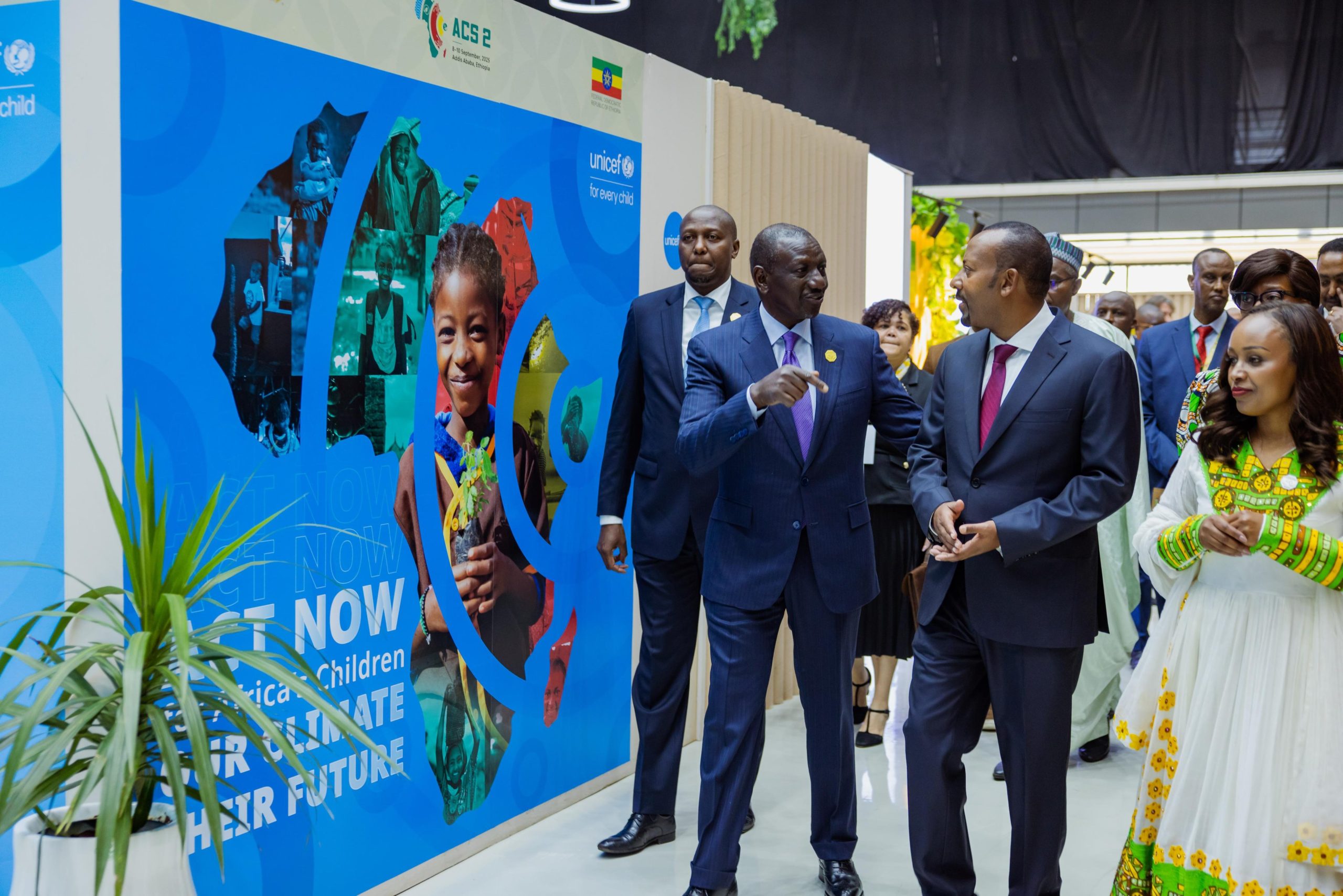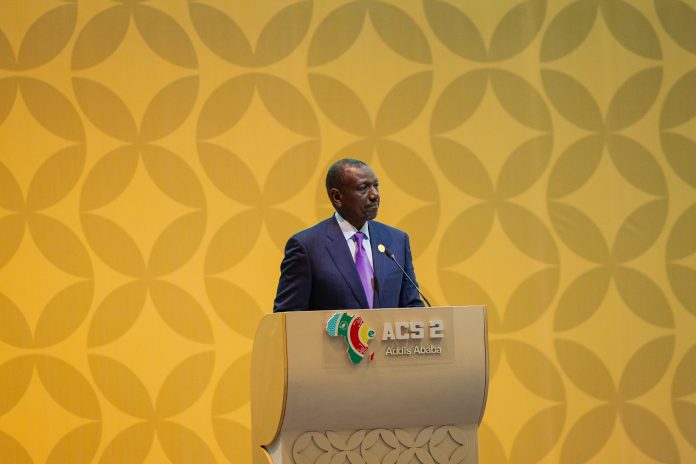Kenya has unveiled a landmark progress report on Africa’s climate agenda, mapping the continent’s achievements and persistent challenges since the first Africa Climate Summit (ACS) in Nairobi last year. Titled ‘From Nairobi to Addis Ababa: Africa’s Journey of Climate Action and Partnerships’, the report was tabled at the second Africa Climate Summit in Addis Ababa and framed by President William Ruto as both a stock take and a forward-looking strategy for Africa’s climate response.
The document positions ACS2 as a decisive moment to move beyond commitments made in Nairobi and toward concrete delivery. President Ruto underscored the Nairobi Declaration’s enduring significance, describing it as a political compact requiring Africa to deliver at home while the international system creates space for the continent’s climate, business, and development goals to converge.
The report’s most pointed assessment concerns Africa’s slow pace in the energy transition. Installed renewable capacity rose marginally from 63 gigawatts in 2023 to 67 gigawatts in 2024, leaving the continent with about 1.5 percent of global capacity. Access to electricity remains uneven, reaching only 61 percent of Africans, while average annual per capita energy consumption is just over 4,000 kilowatt-hours, less than one-fifth of the global average.
The gap in clean cooking solutions is even more severe, with nearly one billion people lacking access to clean fuels and technologies. The human cost is stark: indoor air pollution linked to traditional cooking methods is estimated to cause more than 800,000 premature deaths annually. The report warns that without a decisive acceleration, the Nairobi Declaration’s target of 300 gigawatts of renewables by 2030 will remain out of reach.
Despite the slow aggregate progress, the report highlights several initiatives that have advanced since ACS1. The Accelerated Partnership for Renewables in Africa (APRA) has grown to ten champion countries and convened its first investment forum in Nairobi, where roughly $2.5 billion in projects were consolidated. A dedicated implementation office has been established in Nairobi under UNOPS to coordinate delivery.

The Alliance for Green Infrastructure in Africa (AGIA) secured a first close of $118 million for its project preparation facility in August 2025, advancing toward a $500 million target. In parallel, Mission 300, launched under the Dar es Salaam Energy Declaration, is targeting universal electricity access for 300 million people by 2030. It has already attracted pledges of nearly $90 billion, including $40 billion from the World Bank and $15 billion from the African Development Bank.
Read also: Africa witnesses rare ‘Blood Moon’ in longest eclipse of the year 2025
A longer-term vision is set out in the Continental Power System Masterplan, which projects an increase in generation capacity from 260 gigawatts in 2023 to over 1,200 gigawatts by 2040. Achieving this scale-up would require an estimated $1.3 trillion in investment.
The report is careful to note that new energy capacity alone cannot drive inclusive development without parallel investments in infrastructure and regional integration. Only 43 percent of Africa’s road network is paved, while mobile broadband covers 86 percent of the population but actual internet usage stands at just 37.5 percent.
Trade integration also lags. Intra-African trade accounts for only 16 percent of the continent’s total commerce, while Africa’s share of global trade remains about 1.8 percent, valued at $1.4 trillion in 2024. Manufacturing contributes little to GDP and employment, leaving African economies vulnerable as exporters of raw commodities rather than value-added goods. The report calls for urgent action to leverage the African Continental Free Trade Area (AfCFTA) as a driver of industrialization linked to the energy transition.
Agriculture remains central to Africa’s development prospects, yet the sector faces intensifying pressures. The continent holds 1.1 billion hectares of agricultural land, but only five percent is irrigated. Food insecurity has worsened sharply, with 163 million people affected in 2024. Fertilizer imports, currently costing about $15 billion annually, are flagged as a major vulnerability that could be addressed through regional manufacturing and distribution hubs.
Deforestation continues at a rapid pace. Africa lost nearly 3.9 million hectares of forest annually between 2010 and 2020, the fastest rate worldwide, leaving forests covering about 21 percent of land area today. Marine ecosystems are equally under strain, with only 16 percent of territorial waters formally protected. The report identifies nature-based solutions and regional value chains as essential to both adaptation and climate mitigation.
Above all, the report identifies finance as the central obstacle to progress. Africa received $47 billion in climate finance in 2023, less than a quarter of the $190 billion the continent requires each year by 2030. Public debt pressures are mounting: 21 countries are either in or at high risk of debt distress, with external debt servicing costs projected at $88.7 billion in 2025.
Several innovations are highlighted. The Global Solidarity Levies Task Force has advanced with eight countries introducing a levy on premium air travel to raise predictable resources. The Africa Carbon Markets Initiative is building a framework for more equitable participation in global carbon trading. Meanwhile, the Alliance for Green Infrastructure and blended finance models aim to de-risk private investment at scale. Yet the report is blunt: without deeper reform of multilateral financial institutions and a shift toward concessional finance, Africa’s climate and development agenda will remain underfunded.
The Addis Ababa summit is framed as the moment for Africa to press for implementation and accountability, both at home and internationally. The report emphasizes that progress requires a dual commitment: African governments must advance reforms, strengthen institutions, and align national plans with continental programs, while global partners must restructure finance and trade rules to recognize Africa’s climate and development priorities.
From Nairobi to Addis Ababa is not a rhetorical statement but a detailed progress tracker, blending statistics with policy milestones. For Africa’s sustainability community, it offers a clear picture of where gains have been made, where gaps persist, and where the next battles will be fought. Whether the continent can move from ambition to large-scale delivery will define the credibility of the Nairobi Declaration and the broader global climate response. Access the full report, here.
Read also: Intra-African Trade Fair 2025 opens in Algiers with $44 billion in deals projected







